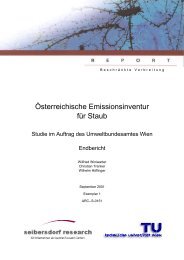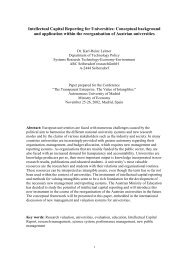ALPMON FINAL REPORT - ARC systems research
ALPMON FINAL REPORT - ARC systems research
ALPMON FINAL REPORT - ARC systems research
Create successful ePaper yourself
Turn your PDF publications into a flip-book with our unique Google optimized e-Paper software.
Contract ENV4-CT96-0359 <strong>ALPMON</strong><br />
3.3.7 Classification<br />
Classification in the test sites had to fulfil the requirements of the local as well as the European<br />
customers. This was taken into consideration with the selection of special classes for each application.<br />
However, classes which had been defined as common classes within <strong>ALPMON</strong> turned out to be not<br />
existing in some test sites and therefore could not be classified. This is true for example for broadleaved<br />
forest, which in some test sites only occurs in form of greenalder shrubs. In some test sites age<br />
classes could not be separated, as the natural type of forest has mixed age, whereas e.g. in the<br />
Dachstein area the managed forest is generally dominated by a common age category.<br />
Due to the different customer needs, the main focus of the classification effort was quite different in the<br />
test sites. Whereas the needs of the local customers of the Tarvisio test site concentrate on value<br />
added satellite image products and classification was performed mainly with respect to the Alpine<br />
Convention and CORINE requirements, in other test sites the outcome of satellite image classification<br />
was essential for the local customers. Here, main focus was put on the categories required by the local<br />
customer, such as tree species composition in the Engadine National Park, or different non-forest<br />
vegetation density in the Cordevole test site.<br />
According to the heterogeneous test site characteristics and the varying reference data sets also<br />
different classification methods were chosen. A Maximum Likelihood classification was performed for<br />
the Tarvisio, Mangfall, Dachstein, and Engadine test sites. Thresholds were applied in nearly all test<br />
sites, partly for classification of the forest border, partly for the entire classification. Furthermore, in the<br />
Cordevole and the Engadine test site diverse unsupervised classification algorithms (ISODATA and<br />
Narendra-Goldberg clustering) were used. Some classifications were performed in hierarchical<br />
manner. A forest non-forest separation preceded the separate classification of forest parameters and<br />
non-forest categories respectively in the Tarvisio, Dachstein, and Cordevole test sites. For the Mangfall<br />
test site a completely hierarchical approach was applied. The classifications were based on detailed<br />
signature analyses.<br />
Additional information, such as a DEM, GIS data layers, or digital map layers, was integrated in the<br />
classification process in some test sites. On one hand classes, which could hardly be classified with<br />
sufficient accuracy from the satellite data, where substituted by the auxiliary information sources. For<br />
example in the Dachstein test site the water layer of the digital topographic map was used instead of<br />
classification of water bodies, as these would partly get mixed up with weakly illuminated coniferous<br />
forest. Furthermore, streams could not be classified due to their representation in mixed pixels<br />
together with bank vegetation. On the other hand the auxiliary data supported classification itself by<br />
establishing rules for selected classes (e.g. sealed surfaces do not occur on steep slopes).<br />
Partly, additional features derived from the high resolution satellite data sets were integrated in the<br />
classification process. Texture features were used for the delineation of sealed surfaces in the<br />
Dachstein and Cordevole test sites. The forest non-forest separation in the Dachstein test site was<br />
based on a fused Landsat TM/Spot pan image.<br />
Some main difficulties crystallised in most classifications:<br />
� Forest age in many test sites could not be classified due to the natural appearance of the forest<br />
with a mixture of all tree age categories. Only the Dachstein test site is dominated by managed<br />
forest with a common age class within one stand.<br />
� Forest type in some test sites is mainly mixed, with only a few pure coniferous or broad-leaved<br />
stands.<br />
� Tree species composition is an important information for two applications (national park<br />
management and avalanche risk). However, some tree species cannot be separated sufficiently<br />
(e.g. percentage of larch trees) or at all (spruce, pine, and stone pine). Dwarf mountain pine and<br />
green alder could not be separated sufficiently with the satellite data acquired during the vegetation<br />
period. This is on one hand due to spectral similarity with other coniferous respectively broadleaved<br />
trees and, on the other hand, due to mixture with other tree species in one stand. However,<br />
in the Dachstein and Mangfall test sites it was possible to classify dwarf mountain pine by means<br />
of winter or spring images, where the low growing trees are covered with snow whereas the high<br />
growing trees are snow free.<br />
� Wet lands were well recognised in the Mangfall test site by using the thermal infrared band of<br />
Landsat TM (TM6). However, this approach is not applicable e.g. to the Dachstein test site, as wet<br />
land areas here are relatively small and beyond the resolution of TM band 6 with 120m.<br />
JR, RSDE, ALU, LMU, Seibersdorf, WSL 79




